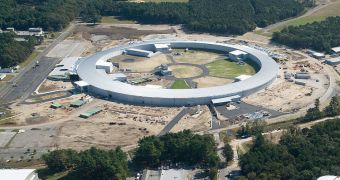One of the world's most advanced light sources is nearing completion in the United States. Housed at the US Department of Energy's (DOE) Brookhaven National Laboratory (BNL), the facility is currently scheduled to begin science operations no later than 2015.
Billed at $912 million, the National Synchrotron Light Source II (NSLS-II) is destined to support a long series of advanced studies, including the design of new materials, increasing energy efficiency and storage, creating better catalyst, synthesizing new drugs, and engineering next-generation electronics.
Officials at the BNL announced yesterday, April 26, that workers had just completed the massive ring building that would house the light source (pictured), and that the NSLS-II linear accelerator had just been commissioned to active duty.
These are two milestones in the NSLS-II construction and development effort, the BNL representatives add. The ring building was built by Torcon, Inc. under a $170 million contract that was signed in 2009. Actual construction work began in April that year.
Analysts say that the construction effort is expected to generate 1,250 construction jobs by 2015. Most of the workers needed will be hired from Long Island and New York State, bringing direct economic benefits to the area. The lab will also employ around 450 scientists, engineers and support personnel.
“This is an exciting time for the project. With the ring building complete, we are moving quickly to install the accelerator and start bringing in components for the experimental stations,” explains NSLS-II project director, Steve Dierker. He is also the associate laboratory director for Photon Sciences.
“The NSLS-II accelerator will consist of three sections: a linear accelerator, or linac, where electrons are generated and accelerated to 200 million electron volts; a booster, which takes electrons from the linac and speeds them up to 3 billion electron volts; and a storage ring, where the electrons circulate to create synchrotron light in the form of X-rays,” BNL expert explains.
This will enable physicists to direct these energetic X-rays towards a number of experimental stations around the ring facility, where various studies will be conducted simultaneously. This type of light is useful for studying anything from solar cells to cellular proteins.
In addition, the NSLS-II installation will enable the study of nanoscale materials and structures, something that is still very difficult to do at less modern installations around the world. Experts will also be able to conduct studies in the fields of molecular electronics and high-temperature superconductors.

 14 DAY TRIAL //
14 DAY TRIAL //